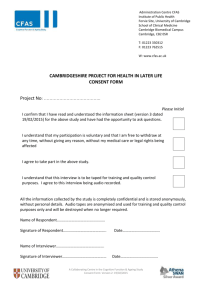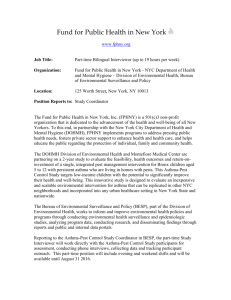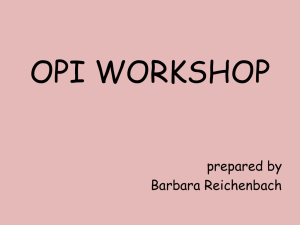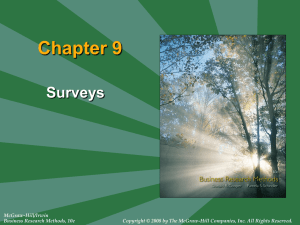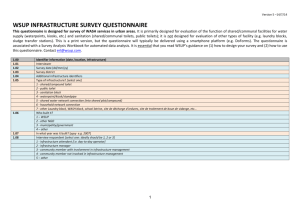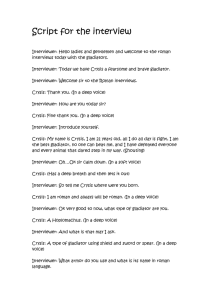Microsoft Word 2007
advertisement
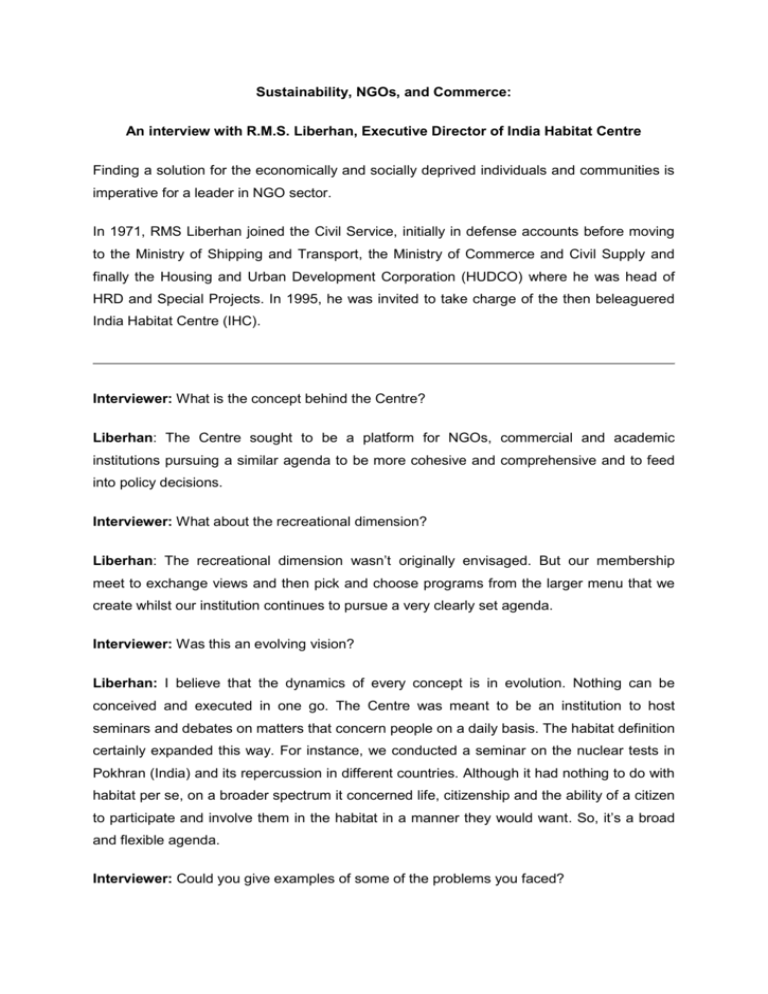
Sustainability, NGOs, and Commerce: An interview with R.M.S. Liberhan, Executive Director of India Habitat Centre Finding a solution for the economically and socially deprived individuals and communities is imperative for a leader in NGO sector. In 1971, RMS Liberhan joined the Civil Service, initially in defense accounts before moving to the Ministry of Shipping and Transport, the Ministry of Commerce and Civil Supply and finally the Housing and Urban Development Corporation (HUDCO) where he was head of HRD and Special Projects. In 1995, he was invited to take charge of the then beleaguered India Habitat Centre (IHC). Interviewer: What is the concept behind the Centre? Liberhan: The Centre sought to be a platform for NGOs, commercial and academic institutions pursuing a similar agenda to be more cohesive and comprehensive and to feed into policy decisions. Interviewer: What about the recreational dimension? Liberhan: The recreational dimension wasn’t originally envisaged. But our membership meet to exchange views and then pick and choose programs from the larger menu that we create whilst our institution continues to pursue a very clearly set agenda. Interviewer: Was this an evolving vision? Liberhan: I believe that the dynamics of every concept is in evolution. Nothing can be conceived and executed in one go. The Centre was meant to be an institution to host seminars and debates on matters that concern people on a daily basis. The habitat definition certainly expanded this way. For instance, we conducted a seminar on the nuclear tests in Pokhran (India) and its repercussion in different countries. Although it had nothing to do with habitat per se, on a broader spectrum it concerned life, citizenship and the ability of a citizen to participate and involve them in the habitat in a manner they would want. So, it’s a broad and flexible agenda. Interviewer: Could you give examples of some of the problems you faced? Liberhan: When I arrived, there was very little money in the Centre and there were some huge bills pending against different contractors and the design and development work was in different stages of completion. So the first question was where the resources would come from. The sponsors were “not an endless supplier of treasure” and there had to be a sound financial plan on spend and obligations. We decided that we’d have a seminar room, a hospitality area and a guest area but then we got jammed in a legal battle with no resource coming from our sponsors, so we then had to pursue our own agenda as well. The fundamental issue was to convince the sponsors that the institution would be a success, and that they would get a return on their investment. Interviewer: How do you see Habitat’s story in a context where so many other worthy projects in India have not been successful? Liberhan: I think everything is possible in this country albeit with 30 per cent extra costs, 30 per cent extra time and an additional ten per cent extra time from those who are pushing it. The climate and the environment are such that one has to move subtly, but confidently towards one’s purpose; you can’t confront others just because you believe that you are right. It takes a little more effort than perhaps in Western countries to carry the team forward and to convince every one of the benefits of their participation. Interviewer: What were the strengths of the organization when you joined the Centre in 1995? Liberhan: The biggest strength was that it was a very lean organization with a low overhead. It also had a compact decision-making body (despite the stakeholders) that received inputs from everyone but ultimately made their own decisions. Of course, there were institutions that didn’t feel like participating in the overall IHC philosophy. They cared for their own office space and seemed to be indifferent to other areas of development, which is where the executive body intervened. Interviewer: What were the major barriers you faced? Liberhan: There were reservations as to whether it was a good proposition which would work. At that point, we were dependent on advice from external agencies and it became important for the decision-makers to pick the right course from the choices offered. Of course, there were crucial external barriers which could inhibit decision being made. You may say I can make a decision in five minutes, but someone else would say you can’t do this, you can’t do that. Interviewer: How did you go about overcoming these difficulties? Liberhan: Basically you have to make all the stakeholders feel wanted. You have to create an environment where their participation is free, fair and, whatever their opinions they have to be appreciated but perhaps sometimes have to be persuaded to an alternative and sometimes more expedient course. In short, one has to be transparent and communicative, taking opinions and criticisms and then muting the criticism by trying to resolve the issue. Interviewer: How much of organizational model did you have to create when you arrived? Liberhan: The greatest advantage of our approach is that we have intellectual inputs from diverse backgrounds and then we have people with a breadth of ability who are vested with the responsibility to deliver, picking ideas from the committees, structuring them into achievable options which they then carry out. We have to cater to a broad constituency of participants in our different programs. So we had to put in place the program advisory committee because we needed inputs from the media scientists and the academics to build the personality of the Centre. Then we had to put in place an art gallery where, year-to-year we could archive the events that take place here as a source for future reference. Interviewer: Were you tempted to go back to the government model? Liberhan: There is some merit in the government model. It’s insulated against anyone who is trying to fool around with it. But here we didn’t need such a model because we were dealing with people of different hue who visited the Centre, participating in its activities. We have to have a very fast reactive and responsive system. If a need is identified, you don’t need to submit a proposal for approval. If there is a genuine user need we can instantly react; the consequences of what you do in the morning are there for you to see in the evening. I recall an interview with a legendary Canadian ice hockey player when asked the secret of his success, he said: “the success is not about being where the puck is, it’s about knowing where the puck is going to be”. That is the critical issue, how much can you anticipate the needs of the visitors, the users and the other players whilst also assessing and developing the capabilities of the institution to fulfill those needs. Interviewer: India Habitat Centre has a track record for innovation, for example, the food court. To what do you attribute your continued success? Liberhan: We maintain a constant dialogue with our hospitality services providers and discuss what we want in the Centre. The architect of the Centre, Joseph Allen Stein, had a vision of wonderful spaces for people to walk through and people with various interests such as art, cinema, theatre, etc. converge on these paths and the food courts were part of the original plan. In addition, we consistently evaluate the choices of users and members and evolve accordingly. We also invite feedback from members and, where we do get complaints, we are sensitive to criticism. Interviewer: When you joined the Centre in 1995, was it down to you to evolve a new sustainable business model for the Centre? Liberhan: My problem was that I had to think of getting some money to carry on because up until then no maintenance charges had been levied. So members were then requested to pay the maintenance charges for at least a year in advance in order that I could meet some basic needs. On the one hand, we had created about 1100 square meters of hospitality area but on the other we were entangled in a legal conflict. The aim was to resolve the conflict and get going as soon as possible. Interviewer: What do you think are your strengths as CEO? Liberhan: I quickly identify what the job is, and then go to people who are supposed to do it and make them understand what it is and how it should be done. I’m transparent about failure and accept it and flexible enough to change course if it leads to success. But sometimes I find myself in a no-nonsense mode and say that I won’t take any more crap; one has to draw a line beyond which you are not prepared to tolerate whilst maintaining a level of patience and respect for people. Interviewer: What do you think are your weaknesses? Liberhan: I’m lazy I suppose. I do believe at times that something you can do tomorrow can be put off till the day after. But I also believe you have to ensure that your weaknesses are concealed and strengths are displayed. Interviewer: Do you think you are a good leader, a good manager or a good administrator? Are you more comfortable with the big picture or the details? Liberhan: I think you have to have the basics of the big picture. You have to have some kind of a dream and the ability to deliver and for this you need to concentrate on the details. Any number of people can have the big picture in mind, but to be able to make it work, there are a number of small pictures that need to be painted and put in place. For example, we started a learning center here with some IT architecture. We wanted to partner with one of the NGOs to give the marginalized communities a chance to interact and learn some of the IT skills so they could use them to enhance their living. It was a vague dream; the Centre needed to be seen as contributing to society in general. So suggestions flowed in to have a 2020 vision or a 15 years perspective and so on. But I said I needed to have a vision for day one, the first hour. Ultimately, through the consultative process we identified our first three steps and then after working on the first three we moved onto the next four-five-six, and that’s how we moved on. Interviewer: Do you think India Habitat Centre could be a model for other centers in the country? Liberhan: It certainly is emerging as a model for institutions. I think it’s a waste of time trying to create more Habitat Centers in X, Y, or Z city. What needs to be done is to identify the theme and philosophy of an institution without which it will die. And having done that, you need to understand the characteristics of the users and make sure your theme and philosophy reflects their personality. You can’t import philosophy from ten thousand miles and use it here. Interviewer: What is your philosophy of management? Liberhan: Bat straight all the time. That’s very important. You need to be seen and believed to be fair and straight all the time and no matter what the pressures; you’ll not compromise on fairness. It’s okay to compromise when essential, but certainly not to dilute the degree of equity to people who are affected by those decisions. Lessons Learned: Liberhan is an advocate of economic sustainability of the government departments so that they are self-dependent and generate sufficient revenues for their longterm existence. He strongly believes that commerce is inextricably linked to philosophy and opines that philosophy without commerce can’t exist for too long. Liberhan has strong foundations in the academic disciplines of arts, law, and sustainability. His experience in managing, involving and interacting with both national and international stakeholders and institutions is unique from the Indian perspective.

